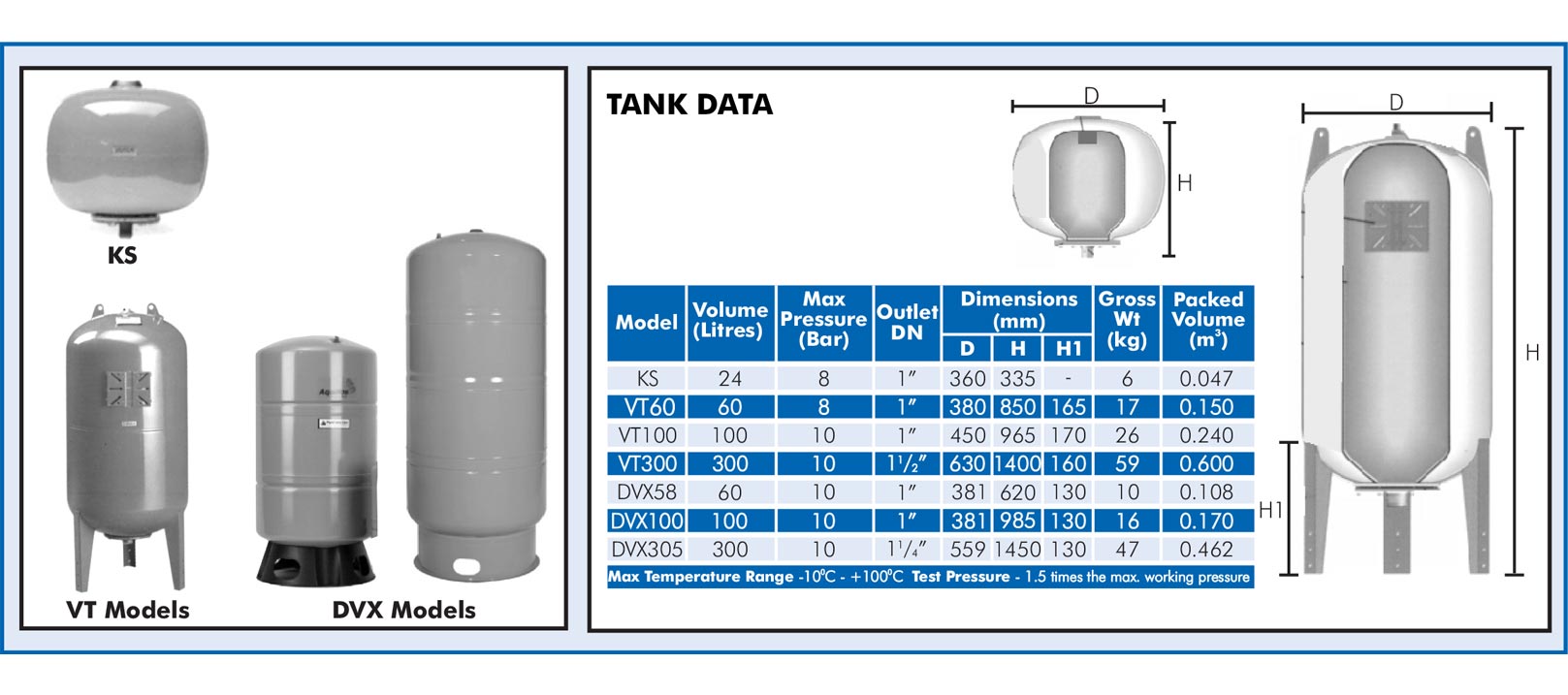Pressure Tanks
Product Overview

Product Details
Pressure tanks are important components of pressurised booster supply systems where automatic pumped water supply is provided by means of pressure switch controlled pumps. The tanks have two functions; to cushion pressure surges as the pump starts and stops and also to provide a drainage supply into the system to control pump cycling. Options are as follows:-
Dayliff VT series pressure tanks have been specially designed for pressurised booster installations and are also suitable for firefighting and irrigation systems. The design incorporates a replaceable butyl rubber membrane which offers the following features:-
Suitable for all types, including corrosive and hard, waters as the water only comes into contact with the membrane.
Membrane design eliminates the necessity for constant air recharging.
Horizontally collapsing membranes (except KS model) avoids contact with tank sides and therefore increases life.
Membrane is simply replaceable.
Dayliff DVX series are higher specification diaphragm type tanks which are specially suited for medium to heavy duty pressure boosting and storage applications where value and reliability are demanded. Features include;
Polypropylene liner and butyl diaphragm for long life and safety.
Corrosion resistant baked epoxy coating finish.
Leaf-free, O-ring sealed air valve cap dispensing the need for maintenance.
AISI S/S 304 water connection to protect against corrosion
All Dayliff pressure tanks are thoroughly tested and conform to various international standards and when properly specified will provide many years of reliable maintenance free operation
Pressure Tank Sizing Guide
Correct tank sizing is important and is determined by the system flow rate and pump start and stop pressure settings. Sizing must be based upon the system flow at which the maximum cycle frequency occurs. As a rule of thumb this can be taken as 65% of the flow at pump stop pressure. Required draining volume is then the maximum cycle frequency flow divided by twice the specified maximum number of cycles per hour. Generally 60 cycles per hour is considered acceptable. Tank size selected is then that nearest to the volume required. Drainage volume is as follows:-
| Tank Pre-charge (Bar) | 1.35 | 1.65 | 1.85 | 2.35 | 2.35 | 2.83 | 3.85 | 4.85 |
| Pump Start Pressure (Bar) | 1.5 | 1.8 | 2.0 | 2.5 | 2.5 | 3.0 | 4.0 | 5.0 |
| Pump Stop Pressure (Bar) | 2.5 | 3.0 | 3.5 | 4.0 | 4.5 | 4.5 | 6 | 7.5 |
| Drainage (%) | 26 | 28 | 28 | 34 | 34 | 26 | 28 | 29 |
| Tanks Model | Drainage Volume (Lives) | |||||||
| KS (24 Litres) | 6 | 7 | 7 | 7 | 8 | 6 | 7 | 7 |
| VT 60/DVX58 (60 Litres) | 15 | 17 | 19 | 17 | 21 | 16 | 17 | 17 |
| VT 100/DVX100 (100Litres) | 26 | 28 | 31 | 28 | 34 | 26 | 28 | 29 |
| VT 300/DVX305 (300 Litres) | 77 | 83 | 93 | 85 | 103 | 78 | 83 | 86 |
Selection Example
System Parameters
Pump Stop Pressure = 4.5 Bar
Stop Flow = 11m3/hr
Pump Start Pressure = 2.5 Bar
Start Flow = 16m3/hr
System flow at maximum cycle frequency = 65% of Pump Stop Flow = 0.65x11=7.2m3/hr or 7200l/hr
Max Cycle frequency = 60cycles/hr therefore required drainage volume = 7200/60x2=60litres
From table: 100 litre tank has drainage volume of 34 litres at defined pressures.
300 litre tank has drainage volume of 103 litres at defined pressures.
Therefore select either 2x100litre tanks (68 litres drainage volume) or 1x300 litre tank (103 litres drainage volume).
Note that when specifying pressure systems the following is important:
- Correct tank pre-charge is critical and must be 0.15 Bar below the pump start pressure. Efficiency is greatly reduced if pre-charge is either too high or too low.
- Ensure that the difference between start and stop pressure is as high as possible as the larger the differential the greater the tank drainage capacity.
- Ensure the pump start pressure is higher than the system static pressure or else the pump will not start.
- Adjust pump stop pressure to be about 90% of the pumps closed head pressure.
Read More Show Less






